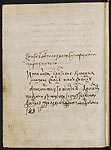Tetraevangelion. Middle of 17th cent.
Q (185 ı 140). 426 leaves.
Paper. Ink, cinnabar, colours, gold.
It is written in a semi-uncial hand.
The illumination of the manuscript includes four Evangelist portraits (fols. 11v, 115v, 190v, 312v). There are painted head-pieces in the Early Printed style in colours and gold (fols. 13r, 117r, 192r, 314r, 411r). The Orthodox Liturgical Calendar is preceded by a small head-piece in gold (fol. 411r). Large initials in ink, pastel colours and gold are worked in diverse styles. Headings are written in gold with use of ligatures. The tabels of gospel readings on the first folios of each Gospel are also written with use of gold.
The manuscript is remarkable not only for its artistic decoration but for its monastic history recorded in notes. The Gospel change hands many times. During the short period of time it served for reading in the cell to several startsy (elder monks and spiritual guides) of the Solovetsky Monastery. The book was donated to the Monastery by Starets Isaac, a sacrist. Then it was sold from the treasury to the cellarer Isaiah nicknamed Favourite. After the death of Starets Isaiah in 1656, the book again passed into the possession of the Monastery. The new owner of the Gospel became the pupil of Starets Isaiah Gerasim Firsov, a noted lover of books from the Solovetsky Monastery, who belonged to the circles of the elder Solovetsky monks, united for a protest against Patriarch Nikon' reforms of the Russian Orthodox Church. Gerasim Firsov compiled some polemic works to adduce evidence of the "former faith". The most-known of them is his treatise about the use of two fingers instead of three while making the sign of the cross. In 1666 Gerasim Firsov suddenly died in 1667, when he was summoned by authority to appear before the ecclesiastical council in Moscow for the "admonition". His books passed into the possession of the Solovetsky Monastery.
In 1928 the manuscript came into the State Public Library along with the collection of the Solovetsky Monastery.
Shelfmark: –Õ¡. —ÓÎ. 133/133.





